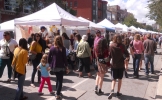Looking Beyond Craft Fairs and Stores
Like a parent of a girl about to go on her first date, I like to meet the buyer of my handmade goods. Unlike the parent, however, I'm less worried about how my crafts will be treated and much more excited to see who likes my stuff.
While selling online is a great way to reach people, meeting customers face-to-face is much more satisfying. Standard direct-to-customer opportunities like craft fairs and art festivals can be infrequent, however, which is why I've compiled some craft fair tips for how to sell crafts at alternative venues. Here's how to approach each of them:
- Concerts
One of the easiest craft fair tips for getting your work in front of people is the barter system — if you're friends with a band (or in a band yourself), offer to run the merch table at shows in exchange for selling your goods as well. - College Campuses
A college campus is a great way to start branching out, when you're thinking about how to sell crafts at different venues. When I was in college, I was part of a DIY club. Leading up to the winter holidays, we'd reserve a table in the student center and pile it high with scarves, hats, shirts, and other handmade goods. It was one of the most consistently successful craft sales I've ever done, with a steady stream of students, faculty, and staff browsing through our wares. If you're currently in college, there's a very good chance you can reserve a table on your campus for free (if you're not a student, you'll probably have to pay a vendor fee). Who books student-union space varies by college; call the school's information line if you can't easily find who to contact on the college's website. - Community Events
A fair doesn't need to be a craft fair in order to have craft vendors, and learning how to sell crafts at these events is fairly easy. Community festivals, holiday celebrations, and flea markets often feature people selling their handmade wares. Table fees can range from nothing to thousands of dollars depending on the size and location of the event. Smaller events should have someone running the event who you can contact directly to determine how to sell crafts there, while larger events will have a more structured vendor application process. - First Friday
On the first Friday of the month, galleries in many towns and cities will stay open late, offering free food and drinks to masses who wander around. In many cities, independent artists will set up small sales displays on the street near the galleries. One thing to keep in mind: Selling on the street without a permit isn't legal in many places, but that illegality is often ignored on First Friday. - Sidewalks
If you'd like to do sidewalk vending on a regular basis without festival or event, you'll need a street vendor permit. Rules vary from city-to-city and state-to-state, but the U.S. government has a guide on how to sell crafts as a street vendor that can get you started. This also means you'll need to pay taxes on all of your earnings, so it's best not to go the street vendor route unless you're ready to make your handmade goods a serious job.
These craft fair tips aren't just for regular shows — they will help you think outside of the box the next time you're looking for an unique place to sell your work. Even if it's not a traditional venue, remember, it never hurts to ask whether you can put out a table with your handmade work!





